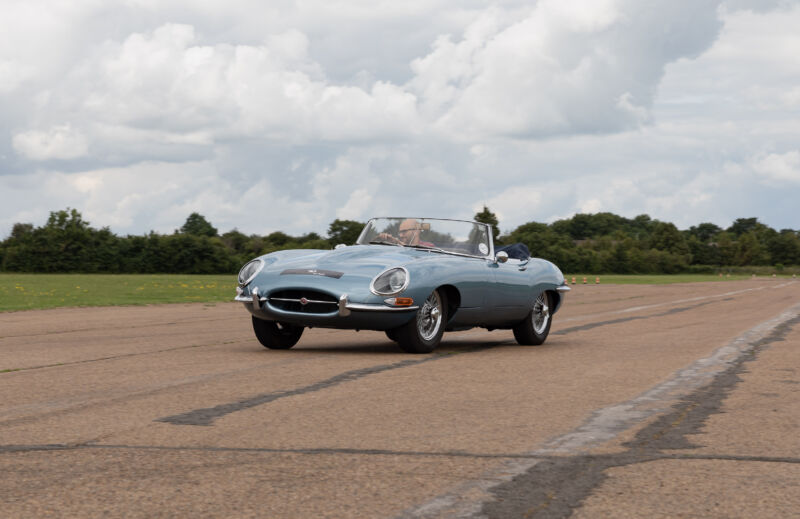
Few things are as wonderful as classic cars. They come with pretty lines and tactile switches. They make people of a certain age think you're living some sort of dream, and people on the Internet will celebrate you. Having a kickass car from years gone by sitting in the driveway is awesome… so long as you're cool with wrenches, oil, and getting to know a mechanic. They need work, and depending on whether you get one that was well-built 60 years ago, some need more than others. This is mostly because of the big sweaty engine up front. If you have time and money, or like spending hours looking for that one ratchet that everyone uses, bully for you. If you're a little more pressed for time, Electrogenic has a solution.
Electrogenic has two methods of electrifying your car.
The Kidlington, UK, company will take your classic, remove all the fragile oily bits, and replace them with an electric setup. If you have a classic that hasn't had the full EV treatment yet, your car will be taken in, scanned, and options will be presented to you. Your preferred balance of range and performance will be weighed up, and an ideal solution found.
Obviously, turning a classic Mini into a 1,000 hp (746 kW) 400-mile (643 km) range monster isn't possible because of packaging issues—Minis are small—so some expectation management is required. Electrogenic will test your car, wire everything up, and you'll be away. You can even keep your manual gearbox (if you had one fitted to start with) or remove the stick and clutch pedal entirely and then have an automatic.

If Electrogenic has converted a few of the same model, there's a chance it already has a ready-to-install kit for your car. So far, the "off the shelf" list includes the Jaguar E-Type, Land Rover Defender, Series Land Rover, and Porsche 911, with more on the way. Those kits need to be installed by trained partners, but more and more of those are popping up all over the world, with three in the US, in Texas, California, and New Jersey. There's a Classic Mini kit, too, which is plug-and-play and not quite as involved. Send your money to Oxfordshire, and a box will arrive at your nearest garage to be installed.
Not a restomod, just powertrains
What Electrogenic won't do is restore your car. It's a powertrain business, not a restoration business. If a car isn't structurally sound, the company won't modify it—an unsafe vehicle is, well, unsafe. The process is entirely reversible if you change your mind.
On top of electrifying consumer cars, the company is also working with the UK's Ministry of Defense. As of April 2023, there are four military Land Rover Defenders being fitted with Electrogenic kits to undergo testing in the hopes that, should it work for the MOD, the EV Landies will become a part of the Army's fleet. In the long term, of course, military vehicles will all be replaced, but for now, why not swap out some engines for electricity and keep what's there running for longer? Private customers will be pleased to know that they get the same kit off the shelf, so they can tell their mates their cars are mil-spec.
What the E-Type Electrogenic has to play with is rather pleasing. A stunning blue with a black interior, its dials and switches all function—the fuel gauge shows charge, for example, drive/neutral/reverse are baked into the car's choke lever, and the three drive modes (eco, normal, and sport) are toggled via the car's map light switches' three positions. The leather is in good condition, and its thin wood-rimmed steering wheel is wonderful to use.

Of three possible E-Type options—E43, E48s, and E62, each number relating to battery kWh—its owner has plumped for the base E43 set up of 160 hp (120 kW), 457 lb-ft (620 Nm), and a 150-mile (241-km) range, which costs about $120,000 after you provide the car. E62 ups the power to 201 hp (150 kW) and the range to 200-plus miles if you pay more.
Ergonomically, the E-Type is just as it was when it left the Coventry, UK, factory in the 1960s, which means that if you struggle with Jag's darling, you'll probably want to avoid one of these. It's just as pretty as the day it was finished, so you'll cause a stir as you roll around town.
With Electrogenic's smaller battery kits on board, the E-Type is up to 198 lbs lighter than the original car—the top spec, thanks to more batteries, is roughly the same weight as the original. The batteries are stored under the hood and behind the rear seats; putting them in the trunk would have upset the car's balance. The goal for any conversion, says Electrogenic, is to make sure it drives as closely to the original as possible.
reader comments
111